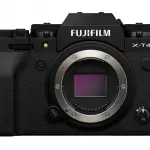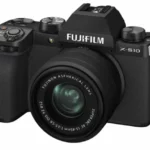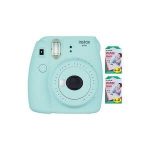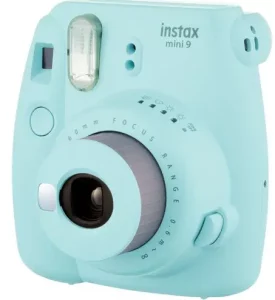

Fujifilm Instax Mini 9 instant Camera
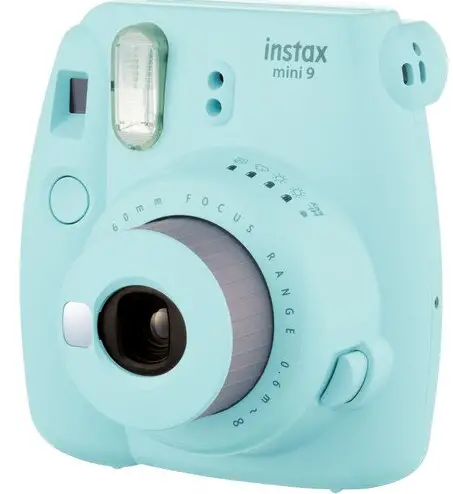
IMPORTANT SAFETY NOTICE
This product has been designed with safety in mind, and to provide safe service when handled correctly and in accordance with the User’s Guide and instructions. It is important that both the product and the INSTAX fi lm are handled properly and used only to take pictures as instructed in this User’s Guide and in the INSTAX mini fi lm instructions. For your ease and safety, please follow what is written in this User’s Guide. It is also a good idea to keep this User’s Guide in a safe, easy-to-find place where you can refer to it if needed.
WARNING
- Never attempt to take this product apart. There is a danger of an electric shock.
- If this product is dropped or damaged so that the inside is showing, do not touch it. There is a danger of an electric shock.
- If the camera or the batteries inside become hot, begin to smoke, make a burning smell or show any sign of unusual condition, remove the batteries right away. Use gloves to keep from burning your hands. Not removing batteries could result in burns or fire.
- Using a flash too close to a person’s eyes may for a short-term effect the eyesight. Take care when taking pictures of infants and young children.
- If your camera gets wet or if something such as pieces of metal get inside, remove the batteries right away to avoid heat buildup or a fi restarting inside the camera.
- Do not use this camera in places where there is flammable gas or near open gasoline, benzene, paint thinner or other unstable substances which can give off dangerous vapors. Doing so could result in an explosion or fire.
- Store your camera out of the reach of infants and young children. Failure to do this could result in serious injury. (For example, the strap could become wrapped around a child’s neck and cause choking.)
- Never take apart the batteries. Do not subject them to heat, throw them into an open fire, or attempt to short-circuit them.
- Doing so could result in the batteries exploding or splitting open causing burns or fire.
- Only use specified batteries in this product. Use of an incorrect type of battery could cause explosion. Dispose of used batteries according to battery disposal instructions.
- Make sure batteries are stored in a safe, secure place and well out of the reach of any infants, young children or pets. Improper storage could result in a child swallowing a battery. (If a child swallows a battery, call a doctor or a hospital right away.)
- Do not look through the close-up lens at the sun or other strong light. Blindness or vision problems could result.
- Never get this product wet or handle it with wet hands. Doing so may result in an electric shock.
- Never take fl ash photographs of people riding bicycles, driving cars or riding a horse.
- The flash can distract the driver and frighten the animal, possibly causing an accident.
- Make sure that the battery C and D polarities are installed correctly in the camera. A damaged battery or electrolyte leakage may cause a fi re, injury, and contaminate the environment.
- Do not touch moving parts inside the camera. You may be injured.
- When using the camera, make sure that the battery cover is attached; otherwise, you may be injured.
- Do not leave the close-up lens in places exposed to strong sunlight. Personal injury or fire could result if the lens should accidentally concentrate the sunbeams on an object or a person.
- Do not swing around the camera. You may be injured.
Parts Name
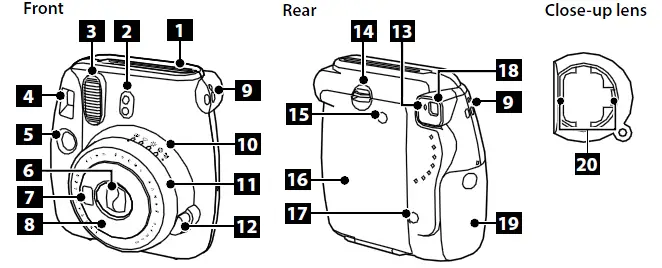
- Film ejection slot
- Light sensor
- Flash lamp face
- Viewfinder
- Shutter button
- Lens/Lens cover
- Self-portrait mirror
- Lens barrel
- Strap hook
- Brightness indicator
- Brightness adjustment dial
- Power button
- Flash charging lamp
- Back cover lock
- Film pack confirmation window
- Back cover
- Film counter
- Eyepiece
- Battery lid
- Tabs (Back)
Inserting Batteries
Caution
- Use new alkaline batteries of the same brand/type only (AA only).
- Do not use any batteries other than alkaline batteries.
- Replace both batteries in the following cases:
- When the red lamp on views under lights
- When no lamp lights or blinks even though the power is turned on
- About 100 pictures (roughly 10 packs of INSTAX mini fi lm) can be taken with new batteries.
- The battery performance may be reduced when it is cold. In this case, warm up the batteries to room temperature before using this camera.
- Use the supplied batteries for validation.

- Push up the battery lid lock, then slide off the battery cover.
- Insert two AA batteries matching the + and – polarities.
- Slide on the battery lid to close.
Loading the INSTAX mini Film Pack
Caution
- Make sure that the batteries are installed before loading the film pack.
- Avoid direct sunlight when loading the film pack.
- Do not use any film other than the FUJIFILM INSTAX mini film.
- When you load the film pack, never press the two rectangular holes on the back.
- Do not open the back cover until you have used up the film; otherwise, the rest of the film is exposed and turns white. The fi lm can no longer be used.
- Never use a film pack beyond its shelf life; otherwise, it may damage the camera.
- For details, refer to the instructions and warnings on the FUJIFILM INSTAX mini-film.

- Press down the back cover lock to open the back cover.
- Hold both sides of the film pack, align the yellow marks on the camera and the film pack as indicated on the INSTAX mini fi lm pack instructions, then insert it straight.
- Close the back cover until the back cover lock clicks into place.

- Press the power button to turn the camera on. The flash charging lamp on the left of the eyepiece starts blinking. (Indicates the flash is charging.)
- When you press the shutter button, the film cover (black) is ejected, and the film counter display on the back changes from “S” to “10”.
- After the fi lm cover has been ejected (the camera stops making a sound), grasp the edge of the film, then take it out. Your camera is now ready to take a photo.
Taking Pictures

- Press the power button to turn the camera on.
The flash charging lamp on the left of the eyepiece starts blinking. (Indicates the flash is charging.) You cannot take a photo while the lamp is blinking. - Turn the camera toward the subject, then turn the brightness adjustment dial to move to the position (
 ) where the lamp is lit.
) where the lamp is lit.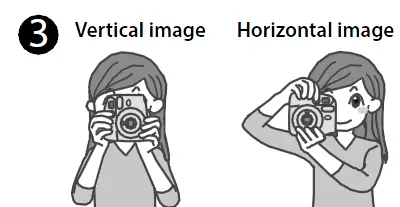
- Hold the camera, confirm the desired composition of the final image, then press the shutter button.
- Keep a distance from the subject of at least 0.6 m. The flash has an effective range of between 0.6 m and 2.7 m.
- The subject will be out of focus using the regular lens if the distance is less than 0.6 m. Use the close-up lens for short-distance photography. Using it enables you to photograph the subject between 35 cm and 50 cm.
- In short-distance photography (including photography using the provided close-up lens), the center of the subject in the viewfinder will be on the upper right on the actual print.
Caution on holding the camera - For a horizontal image, hold the camera with the flash lamp face at the top.
- Do not take pictures where flash photography is forbidden.
- Be careful so that your fingers or the strap do not cover the light sensor, flash lamp face, flash, lens, or film ejection slot.
- Do not grasp the lens barrel when positioning the camera; otherwise, the finished print may not look as expected.
- Look into the viewfinder so that the “O” mark appears in the center.
- Be careful not to touch the lens surface when you press the shutter button.

- Every time you take a photo, the number on the film counter decreases from “10” to reflect the number of remaining photos, and “0“ is displayed when you have used up the film pack.
- When the film has been ejected (the camera stops making a sound), grasp the edge of the film, then take it out.
- When you have finished taking a photo, push the lens barrel to turn the camera off.
Unloading the INSTAX mini film pack
When “0” is displayed on the film counter, unload the film pack following the procedure below and as indicated on the INSTAX mini fi lm pack instructions.
- Press down the back cover lock to open the back cover.
- Grasp the rectangular holes on the film pack, then pull it out straight.
Using the Close-Up Lens
You can photograph objects close-up and can photograph yourself using the self-portrait mirror.
WARNING
Do not look through the close-up lens at the sun or other strong light. Blindness or vision problems could result.
Caution
- Do not leave the close-up lens in places exposed to strong sunlight. Personal injury or fire could result if the lens should accidentally concentrates the sunbeams on an object or a person.
- Switch off the camera before you attach/detach the close-up lens.
- Never turn the close-up lens when you attach/detach it; otherwise, the tabs on the back may be broken.

- Attach the left tab on the back to the left of the lens (1), then attach the right tab (2) so that it clicks into place
- Hold the camera so that the “O” mark in the viewfinder is on the upper right of the center of the subject (see the illustration above), then take a photo.

- Lift up the right side of the close-up lens supporting the left side (1), then detach it (2).
- Hold the camera securely keeping 35 cm to 50 cm between you and the edge of the lens.
- Confi rm the composition using the self-portrait mirror, then take a photo.
Taking a lighter (Hi-Key) picture
This camera automatically determines an appropriate brightness for taking any given picture, and informs you by lighting the corresponding lamp.
To take a lighter (Hi-key) picture, set the position of the brightness adjustment dial to the position of the mode darker than the mode for which the lamp on the dial lights. 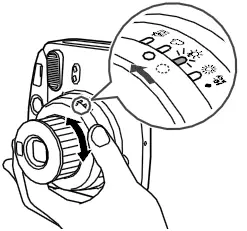

Caution
Do not use the (Hi-key) function outside; otherwise, the picture may be much lighter (whiter) than you intend.
SPECIFICATIONS
| Film | FUJIFILM INSTAX mini film |
| Picture Size | 62 mm × 46 mm |
| Lens | 2 components, 2 elements, f=60 mm, 1:12.7 |
| Viewfinder | Real image finder 0.37× with target spot |
| Shooting range | 0.6 m and beyond |
| Shutter Speed | 1/60 sec. |
| Exposure Control | Manual switching system (LED indicator in exposure meter) |
| Film Feeding Out | Automatic |
| Film Developing Time | Approximately 90 seconds (Varies depending on the ambient temperature) |
| Flash | Constant firing flash (automatic light adjustment) Recycle time: 0.2 sec. to 6 sec. (when using new batteries) Effective flash range: 0.6 m – 2.7 m |
| Power Supply | Two AA-size 1.5V alkaline batteries Capacity: 100 shots
(Approximately 10 INSTAX mini 10-pack film packs with new AA batteries) |
| Auto power off time | 5 min. |
| Others | Exposure counter (number of unexposed films), film pack confirmation window |
| Dimensions | 116 mm × 118.3 mm × 68.2 mm |
| Weight | 307 g (without batteries, strap and film pack) |
* Specifications are subject to change without notice.
TROUBLESHOOTING
During operation
| Problems | Possible Causes | Solutions |
| The shutter release won’t trip. | 1 The battery power is low.
2 The batteries are not loaded correctly. 3 Power is not turned on. 4 Camera has remained idle for roughly 5 minutes with the power turned on. |
1 Replace the batteries with new ones.
2 Load the batteries correctly. 3 Press the power button to turn on the power. 4 Press the power button after retracting the lens or press the shutter release button to restore the power-on state. |
| The lamp on the viewfinder blinks and the shutter release won’t trip. | ● Flash is charging. | ● Wait until the lamp on the brightness adjustment dial is lit without blinking. |
| The film pack won’t load into your camera, or won’t load into your camera smoothly. | 1 The film pack is not for your camera.
2 You are not loading the film pack correctly. |
1 Use FUJIFILM INSTAX mini film only. (No other films can be used.)
2 Match the yellow line on the film pack with the yellow positioning mark in your camera. Follow the INSTAX mini film pack instructions. |
| All lamps on the brightness adjustment dial blink at the same time. | 1 The battery power is low, and it takes a long time to charge the flash.
2 A more significant issue with your camera has occurred. |
● Replace the batteries with new ones while the power is turned on (when the lens is extended).
IMPORTANT: Replace the batteries only while the power is turned on. If you replace the batteries while the power is turned off (when the lens is retracted), the lamps on the brightness adjustment dial blink after turning on the power even with new batteries. |
| * When the problem is due to reason 1, the lamps on the brightness adjustment dial turn off after replacing the batteries.
If the problem is due to reason 2, the lamps on the brightness adjustment dial blink even after replacing the batteries. In this case, turn off the power and remove the batteries immediately, then contact an authorized FUJIFILM repair center. |
||
| The red lamp on the viewfinder lights up. | ● The battery power is low. | ● Replace the batteries with new ones. |
Printed pictures
| Problems | Possible Causes | Solutions |
| The finished print looks over exposed. (White in color) | 1 The method of measuring the subject brightness is unsuitable.
2 Brightness adjustment dial setting is incorrect. 3 The ambient temperature is low (below +5°C/+41°F). 4 The background is too dark in comparison with the subject. 5 The light sensor or flash sensor window is blocked. |
1 Point the lens toward the center of the subject and measure the subject brightness.
2 While pointing the lens toward the subject, turn the brightness adjustment dial to set the brightness to that for which the lamp lights. 3 Before taking pictures, place your camera in a warm place to bring it to room temperature. 4 Turn the brightness adjustment dial one step toward the direction. 5 When taking a picture, be careful not to cover the two small windows next to the flash on the camera. |
| The finished print looks
under exposed. (Dark) |
1 The method of measuring the subject brightness is unsuitable.
2 Brightness adjustment dial setting is incorrect. 3 The ambient temperature is high (above +40°C/+104°F). 4 The picture was taken with direct light in front of you. 5 The flash lampface was blocked. 6 The background is too bright in comparison with the subject. 7 The flash did not reach the subject. 8 The flash reflected back from a mirror or window glass. 9 Grasping the lens barrel did not let the shutter work properly. |
1 Point the lens toward the center of the subject and measure the subject brightness.
2 While pointing the lens toward the subject, turn the brightness adjustment dial to set the brightness to that for which the brightness adjustment dial lamp lights. 3 Before taking pictures, place your camera in a cool place. When the picture comes out from your camera, keep it away from places or objects with excessively high temperature. 4 Take a picture with the light behind you, or turn the brightness adjustment dial one step toward the direction. 5 When holding your camera, be careful not to block the flash lampface with your finger or strap. 6 Turn the brightness adjustment dial one step toward the direction. 7 Take pictures within 0.6 m to 2.7 m from the subject. 8 Adjust your position in taking the picture away from the mirror or window glass. 9 Do not grasp the lens barrel when you take pictures. |
| The picture is out of focus. | 1 The shooting range is too close to the subject.
2 The lens is not clean. 3 Your camera was shaken when taking pictures. |
1 Take pictures with a distance of at least 0.6 m between you and your subject.
2 Clean the lens. 3 Hold your camera firmly and press the shutter release button gently. |
| The picture is blurred. | 1 Picture was not permitted to
develop without touching, pressure being applied or other interference once it is ejected from the camera. 2 The picture did not come out smoothly. |
1 Do not press onto or fold the picture.
2 Do not block the film exit with your finger. |
| The subject in the viewfinder has shifted in the finished print. | ● The shooting range is too close to the subject. | ● Take pictures with a distance of at least 0.6 m between you and your subject. |
Information for traceability in Europe
Manufacturer: FUJIFILM Corporation
Address, City: 7-3, Akasaka 9-Chome, Minato-ku, Tokyo Country: JAPAN
Authorized representative in Europe: FUJIFILM EUROPE GMBH Address, City: Dusseldorf Heesenstrasse 31, 40549
Country: Germany
FCC Statement
This device complies with part 15 of the FCC Rules. Operation is subject to the following two conditions: (1) This device may not cause harmful interference, and (2) this device must accept any interference received, including interference that may cause undesired operation.
CAUTION
This equipment has been tested and found to comply with the limits for a Class B digital device, pursuant to Part 15 of the FCC Rules. These limits are designed to provide reasonable protection against harmful interference in a residential installation. This equipment generates, uses, and can radiate radio frequency energy and, if not installed and used in accordance with the instructions, may cause harmful interference to radio communications. However, there is no guarantee that interference will not occur in a particular installation. If this equipment does cause harmful interference to radio or television, which can be determined by turning the equipment off and on, the user is encouraged to try to correct the interference by one or more of the following measures:
- Reorient or relocate the receiving antenna
- Increase the separation between the equipment and the receiver
- Connect the equipment into an outlet on a circuit different from that to which the receiver id connected
- Consult the dealer or an experienced radio/TV technician for help Changes or modifications not expressly approved by FUJIFILM responsible for compliance could void the user’s authority to operate the equipment.
For customers in Canada:
CAUTION: This Class B digital apparatus complies with Canadian ICES-003.
Disposal of Electric and Electronic Equipment in Private Households
Disposal of used Electrical & Electronic Equipment (Applicable in the European Union and other European countries with separate collection systems)
This symbol on the product, or in the manual and in the warranty, and/or on its packaging indicates that this product shall not be treated as household waste.
Instead, it should be taken to an applicable collection point for the recycling of electrical and electronic equipment.
By ensuring this product is disposed of correctly, you will help prevent potential negative consequences to the environment and human health, which could otherwise be caused by inappropriate waste handling of this product.
If your equipment contains easy removable batteries or accumulators, please dispose of these separately according to your local requirements.
The recycling of materials will help to conserve natural resources. For more detailed information about recycling of this product, please contact your local city office, your household waste disposal service or the shop where you have purchased the product.
In Countries outside of EU: If you wish to discard this product, please contact your local authorities and ask for the correct way of disposal.
COMMON SENSE CAMERA CARE
CAMERA CARE
- Your camera is a precision instrument. Do not get it wet or drop it. Also, do not expose to sand.
- Do not use a strap made for cellular phones or other similar electronic products. These straps are usually too weak to hold your camera securely. For safety, use only straps designed for your camera, and use only as specifically intended and instructed.
- If you are not using your camera for a long interval, unload the batteries and keep it where it will be safe from heat, dust, and moisture.
- Remove soil and dust from the lens, viewfinder window, etc. with an air blower and by wiping lightly with a piece of a soft cloth.
- Do not use solvents such as thinner and alcohol to remove soil.
- Keep the film chamber and camera interior clean to avoid damaging films.
- In hot weather, do not leave your camera in a closed car or on the beach, and do not leave it in moist places.
- Moth-repellent gas such as naphthalene adversely affects your camera and films. Avoid keeping your camera or films in a chest with mothballs.
- Your camera is computer-controlled. If you should experience an operational issue, remove the batteries and then reload them.
Note that the temperature range within which your camera can be used is +5°C/+41°F to +40°C/+104°F.
INSTAX mini FILM AND PRINT CARE
See FUJIFILM INSTAX mini film for fi lm use instructions. Follow all instructions for safe and proper use.
- Keep the film in a cool and dry place. Do not leave the film in a place where the temperature is extremely high (e.g., in a closed car).
- When you load a film pack, use the film as soon as possible.
- If the film has been kept in a place where the temperature is extremely high or low, bring it to room temperature before starting to take pictures.
- Be sure to use the film before the expiration or “Use Before” date.
- Avoid airport-checked luggage inspection and other strong X-ray illumination.
The effect of fogging, etc. may appear on unused film. We recommend that you carry the camera and/or the film onto the aircraft as carry-on luggage. (Check with each airport for more information). - Avoiding strong light, keep the developed prints in a cool and dry place.
- Do not puncture, tear, or cut the INSTAX mini film. If the film becomes damaged, do not use it.
Cautions on handling the film and prints
For details refer to the instructions and warnings on the FUJIFILM INSTAX mini-film.

